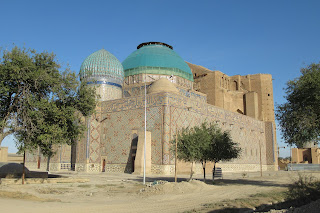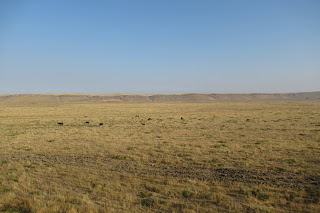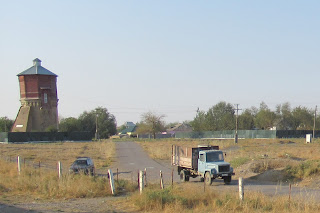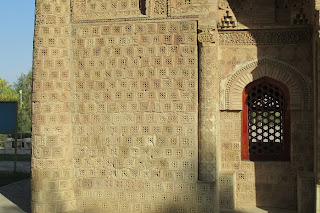 |
| New Mosque of Khoja Ahmed Yasawi |
Travel Dates 2nd-8th October 2019
Click on any picture to see a larger version.
My original plan for my Kazakhstan visit was for two nights each in Turkestan, Shymkent and Taraz before my final two nights in Almaty, departing for home on a night flight which gave me an extra day there. I had plans to see lots of ancient sites in and near Turkestan and Taraz. Sadly, unwise dining on the night train from Khiva to Tashkent led to very limited sightseeing for the first five nights. C'est la vie; maybe I'll get back some day. Despite illness I enjoyed the visit, seeing some ancient sites but also seeing the people and the countryside. That is one of the reasons I prefer rail travel; I see so much more of the landscape and little towns at ground level than I do flying over at 10,000 meters.
Modern Kazakhstan is a vast landlocked country with a population over 18 million and a land area of over a million square miles or just over 2,700,000 square kilometers, slightly smaller than India.. It shares borders with China, Kyrgyzstan, Uzbekistan and Russia. The long Russian border extends from the Volga River region to Siberia. It has a similar history to Uzbekistan. In brief, in the past 2000 years it has had many conquerors including the Huns, Turks, Mongols and several others before eventually the Tsar in the 19th century. The Russians made significant changes to the economy with nomadic tribes dwindling as farming and grazing replaced their lifestyle and high levels of Russian immigration occurred. Kazakhs are now outnumbered by people of Russian descent. There was a brief period of independence after the 1917 Russian revolution but by 1919 they came under Soviet control. The Soviet era included a terrible famine under Stalin, similar to the Ukraine Holodomor, and several periods of rebellion and severe repression, but it also introduced industrialisation as the Russians built industries close to Kazakh primary production and mines.
After the collapse of the Soviet Union the Communist leader, Nursultan Nazarbayev, became the new president of independent Kazakhstan and ruled until he retired earlier this year aged 79. He is still the Chairman of the Security Council and probably the power behind the leader. In '97 he decided to move the capital from Almaty to Akmola and re-named it Astana. This year he re-named it again after himself: Nur Sultan. How humble...
After the night train from hell from Khiva to Tashkent I was fortunate to be the only occupant of my compartment the following night from Tashkent to Turkestan.
We departed on the dot at 01:48. When I checked the route online I was puzzled to see it took over four hours to travel less than 40 km to the Kazakh border. I found the reason swiftly. The train stopped short of the border for nearly two hours for Uzbek officials to check that all who were leaving could be allowed to, then we moved on a short distance and stopped for another two hours for Kazakh border control to let us all in. The official who checked me had a nifty cube-shaped device about 20cm on a side which included a camera, passport reader, screen and keyboard. I was finally able to close my eyes as dawn broke.
After Shymkent we passed several small towns and villages but the landscape was generally flat grazing land with occasional hills.
We passed several towns with abandoned factories, possibly from Soviet times, possibly more recent.
The staff at Khanaka Hotel in Turkestan were wonderful when I arrived off the train shortly after midday and explained I had an urgent need to check in early. If you intend visiting Turkestan I can't praise them enough. Months earlier they accepted my request to purchase all my Kazakh rail tickets. They did not require pre-payment and added only a modest commission. They trusted me to pay on arrival; when I did they happily accepted my debit Mastercard. They arranged for a driver to meet me at the station, the room was excellent 4* standard as was the service and the bed was comfortable. Their breakfast restaurant was not available for dinner but they recommended a good local restaurant, Edem, a short walk from the hotel.
 |
| Mausoleum of Khoja Ahmed Yasawi |
The location was close enough to the Mausoleum of Khoja Ahmed Yasawi for me to walk around it on one of my brief excursions outside the room.
 |
| Main entrance to the mausoleum. |
 |
| Rear view of the mausoleum. |
 |
| Mausoleum of Rabigha-Sultan Begum, a great-granddaughter of Timur |
These pictures were all taken during my short walk.
 |
| Seen in the distance, name unknown |
When I planned the rail journeys from Turkestan to Shymkent to Taraz to Almaty the timing and choice of compartments led to me choosing the same train each time; not actually the same physical train but train O29X Talgo originating in Atyrau, 1200km and one day away in far north-west Kazakhstan, ending in Almaty.
I chose 2-berth VIP for the first two short daytime legs and VIP Grand Luxe (with toilet and shower) for the final longer evening leg. I was lucky; I had a compartment to myself for all three legs. Prices were roughly 7000 тңг (~AU$25) for the short legs and 14000 тңг for the final journey.
 |
| Turkestan Station |
 |
| 029X VIP Compartment |
Shymkent was essentially a transit station for me, to rest and recover. It is an important industrial city and railway junction with some attractions nearby but I was unable to see them. I visited pharmacies in Turkestan and Shymkent; unfortunately none of their over-the-counter remedies were any benefit. This was a pleasant avenue near my hotel with the obligatory statue of a Soviet Hero. Next is a restaurant close to my Hotel FN. The food was excellent but my choice of local red wine would strip paint.
The Pride Hotel in Taraz was interesting. My room was enormous with one odd problem; it took me a few minutes to realise the city mural on the "window" hid the fact that there was no window. But the bed was comfortable and the staff were very helpful.
On my second morning I communicated my need for an English-speaking doctor to the lady in charge. She made a call, then arranged a cab to a medical centre where a Turkish doctor was out the front having a smoke with another doctor. He put me in touch via his phone with his English-speaking brother, also a doctor. To cut a long story short I was then led down to the pharmacy, collected some pills, paid the equivalent of AU25.00 total and took one of each pill. One was Cipro. Magic. By afternoon I was fit to wander again. I wish I had recorded names to be able to thank all involved properly; sadly at the time I wasn't thinking very clearly.
With limited time left in Taraz I first visited the beautiful park where the small Karahan mausoleum is located. It was built in the 11th century over the grave of one of the Katakhanid rulers and reconstructed in 1906.
 |
| Aulie-Ata Karahan |
I strolled down to the corner of the park to see this small mausolem.
 |
| 13th Century Dautbek Shamansur Mausoleum |
As evening approached I took a Yandex cab to the Aisha Bibi mausoleum 20km out of town. It has a pleasant garden entry. It is an unusual construction with carved terracotta tiles representing lace.
The legend goes that 16-year-old beauty Aisha-bibi was just an hour away from meeting her fiancé, the Emir of Taraz, who she intended to wed against the wishes of her father. She travelled from Otrar with her wet nurse. The women stopped at the shore of the Assa River to bathe. As she was emerging from the river and reaching for her clothing she was fatally bitten by a snake that had slithered into her clothes. She died soon after. The Emir was heartbroken after returning from a military mission too late to meet her. He had the mausoleum constructed as an eternal symbol of their love.
Near the mausoleum is another mausoleum dedicated to Babaji Khatun ("wise queen"); it has an unusual dome of sixteen segments.
I noticed this sports arena on the way back to town.
Cheers, Alan





















Alan, I absolutely love your travel itinerary. While my husband and I are inveterate travelers, we can't hold a candle to all the places you've been. Several years ago we spent several weeks in Siberia. However, the population had been so beaten down by this point, it turned into a fairly depressing experience. Folks were terrible to each other, and the rate of alcoholism was astronomical. So, we've tended to stay away from this part of the world afterwards. At any rate, if you could, when you do these lovely travelogues, provide some dates for when some of these mosques were built. I assume these are Sunni Muslims?
ReplyDeleteOK, one more question -- what guide book are you using for these out of the way places?
ReplyDeleteOK, this is the last question: you don't travel with an antibiotic? ; )
Very useful. Thanks!
ReplyDelete